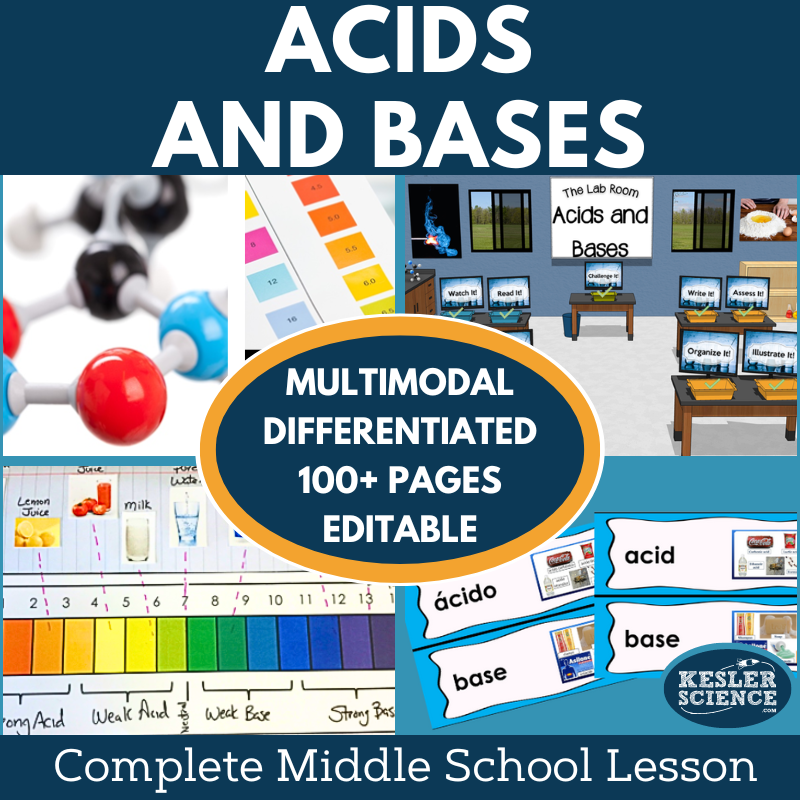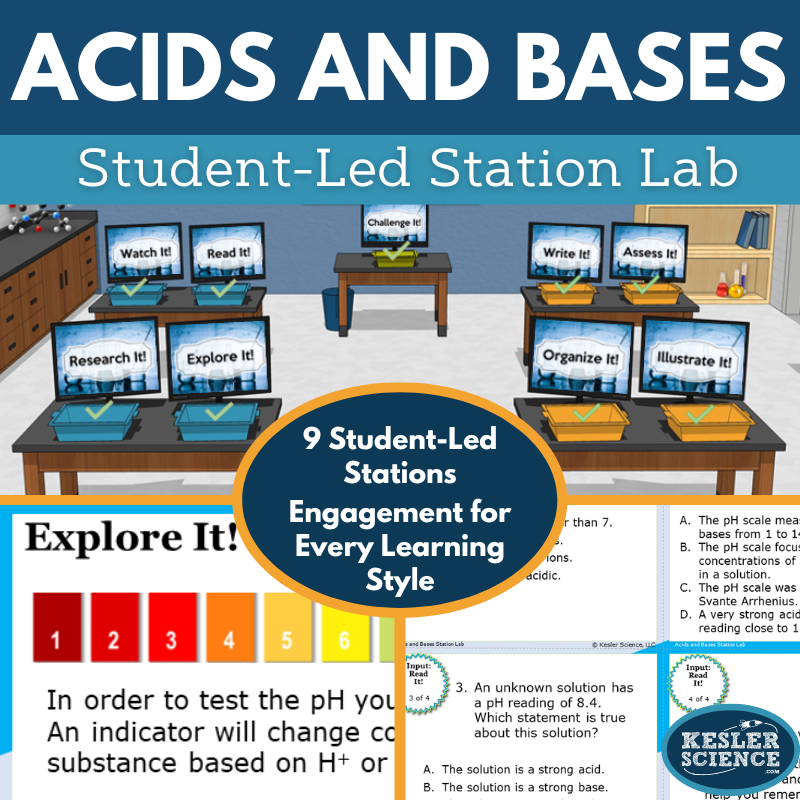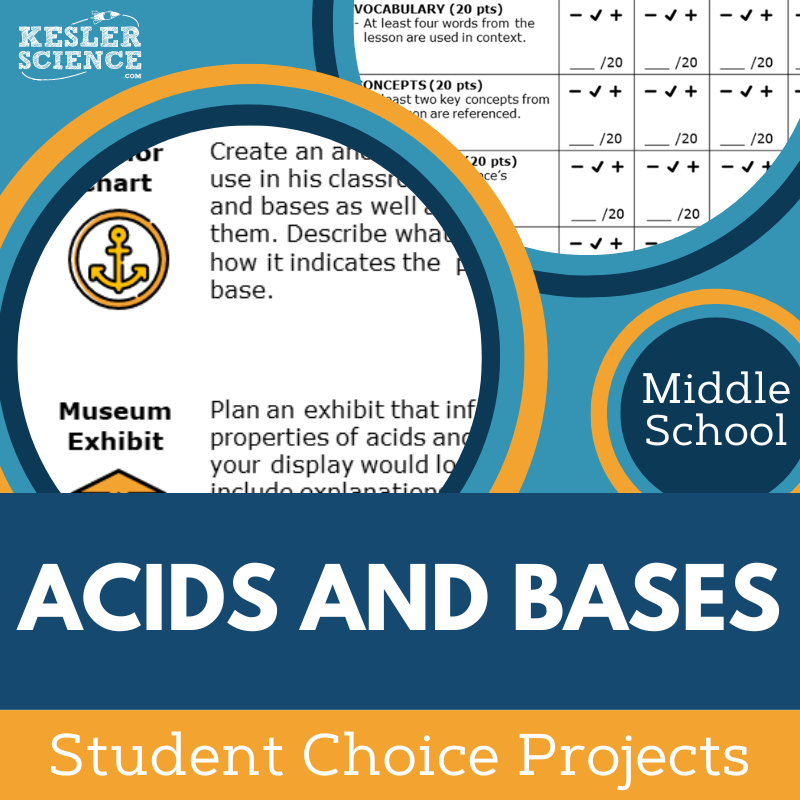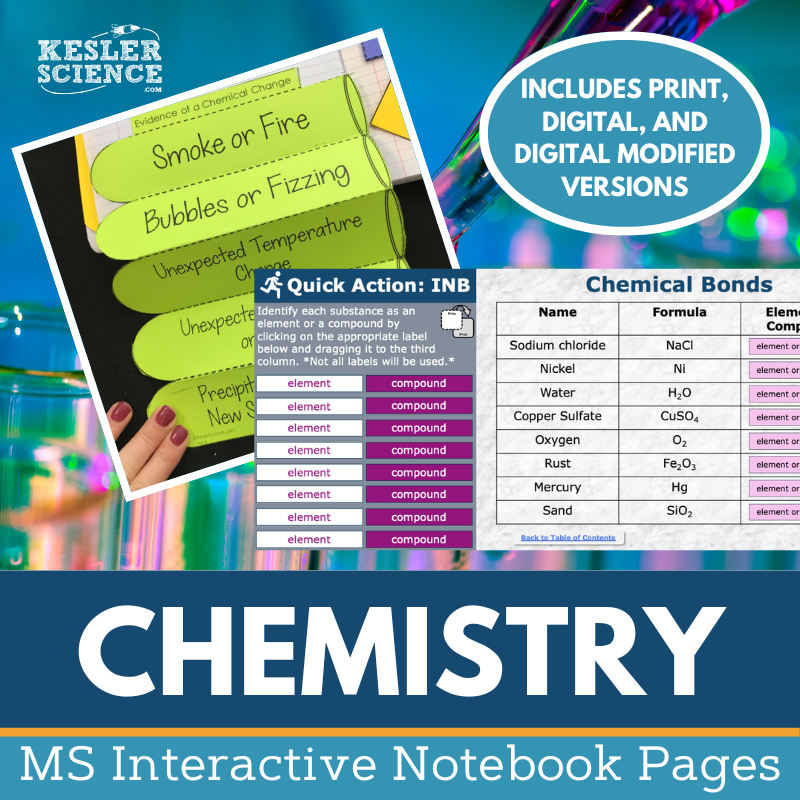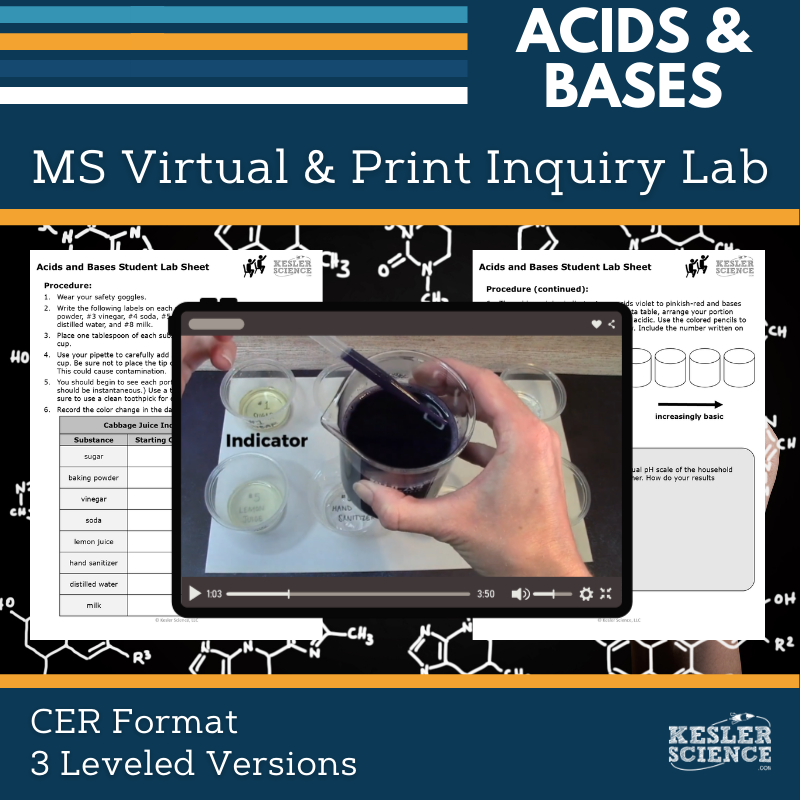Acids and Bases Activities for Middle School Science
The Kesler Science Acids and Bases resources provide engaging, low-prep lessons and activities designed to help middle school students explore key chemistry concepts, including the properties of acids and bases, pH testing, and ion interactions. The resources below will give students a comprehensive understanding of acids and bases. All of the following materials are also included in the Kesler Science Membership.
The Kesler Science Acids and Bases Complete 5E Lesson for 6th-8th grade offers a flexible, low-prep approach to teaching acids and bases through multimodal, student-led learning. This comprehensive lesson includes differentiated materials to accommodate various learning styles and is available in both printable and digital formats. Designed around the 5E Model, it guides students through Engagement, Exploration, Explanation, Elaboration, and Evaluation.
In the Engagement phase, students explore key questions, using objectives and word wall cards in both English and Spanish. The Exploration phase features a student-led station lab with nine differentiated stations, including Explore It!, Read It!, Research It!, Watch It!, Organize It!, Write It!, Illustrate It!, Assess It!, and a Bonus Challenge It! station for early finishers. The Explanation phase offers editable PowerPoints, interactive notebooks, and note-taking templates, while Elaboration extends learning through student-choice projects. Finally, Evaluation includes assessments, review questions, and a worksheet for practice or homework.
This lesson is adaptable for both in-person and virtual learning, providing an engaging and thorough experience for students.
The Kesler Science Acids and Bases Complete 5E Lesson for 6th-8th grade offers a flexible, low-prep approach to teaching acids and bases through multimodal, student-led learning. This comprehensive lesson includes differentiated materials to accommodate various learning styles and is available in both printable and digital formats. Designed around the 5E Model, it guides students through Engagement, Exploration, Explanation, Elaboration, and Evaluation.
In the Engagement phase, students explore key questions, using objectives and word wall cards in both English and Spanish. The Exploration phase features a student-led station lab with nine differentiated stations, including Explore It!, Read It!, Research It!, Watch It!, Organize It!, Write It!, Illustrate It!, Assess It!, and a Bonus Challenge It! station for early finishers. The Explanation phase offers editable PowerPoints, interactive notebooks, and note-taking templates, while Elaboration extends learning through student-choice projects. Finally, Evaluation includes assessments, review questions, and a worksheet for practice or homework.
This lesson is adaptable for both in-person and virtual learning, providing an engaging and thorough experience for students.
The Kesler Science Acids and Bases Station Lab is a modular, student-led activity designed to engage middle school students in learning about acids and bases. This hands-on, differentiated approach allows students to take charge of their learning, while teachers facilitate rather than direct the process. With eight differentiated stations and a challenge station for early finishers, this activity caters to a variety of learning needs.
The nine stations include both input and output activities. Input stations, such as Explore It!, Research It!, Read It!, and Watch It!, allow students to encounter new concepts through hands-on demonstrations, research tasks, reading, and videos. Output stations, like Organize It!, Illustrate It!, Write It!, and Assess It!, provide opportunities for students to demonstrate their knowledge through manipulatives, drawings, written responses, and task cards. The bonus Challenge It! station offers extension activities for advanced learners.
This versatile resource is designed for both in-person and virtual learning environments, with digital versions of the stations available through PowerPoint or Google Slides, ensuring flexibility and engagement in any setting.
The Kesler Science Acids and Bases Station Lab is a modular, student-led activity designed to engage middle school students in learning about acids and bases. This hands-on, differentiated approach allows students to take charge of their learning, while teachers facilitate rather than direct the process. With eight differentiated stations and a challenge station for early finishers, this activity caters to a variety of learning needs.
The nine stations include both input and output activities. Input stations, such as Explore It!, Research It!, Read It!, and Watch It!, allow students to encounter new concepts through hands-on demonstrations, research tasks, reading, and videos. Output stations, like Organize It!, Illustrate It!, Write It!, and Assess It!, provide opportunities for students to demonstrate their knowledge through manipulatives, drawings, written responses, and task cards. The bonus Challenge It! station offers extension activities for advanced learners.
This versatile resource is designed for both in-person and virtual learning environments, with digital versions of the stations available through PowerPoint or Google Slides, ensuring flexibility and engagement in any setting.
The Kesler Science Acids and Bases Student Choice Projects offer middle school students the opportunity to select a project that suits their preferred learning style. The lesson includes six student-led project options plus a “design your own” choice, all outlined on a project page. A flexible grading rubric allows for assessments by teachers, peers, or self-assessment, and can be customized to meet specific grading needs.
The lesson is differentiated to accommodate various learning levels. The modified version includes three projects tailored for students needing remediation, while advanced learners can combine projects for a more challenging experience. Teachers are provided with a direction page offering support, suggestions, and editable rubric pages for assessing vocabulary, concepts, presentation, clarity, and accuracy.
The projects require basic classroom supplies like paper, markers, and scissors, with some optional crafting materials for model-building. Many projects can also be completed digitally, offering a flexible and creative way for students to demonstrate their understanding of acids and bases.
The Kesler Science Acids and Bases Student Choice Projects offer middle school students the opportunity to select a project that suits their preferred learning style. The lesson includes six student-led project options plus a “design your own” choice, all outlined on a project page. A flexible grading rubric allows for assessments by teachers, peers, or self-assessment, and can be customized to meet specific grading needs.
The lesson is differentiated to accommodate various learning levels. The modified version includes three projects tailored for students needing remediation, while advanced learners can combine projects for a more challenging experience. Teachers are provided with a direction page offering support, suggestions, and editable rubric pages for assessing vocabulary, concepts, presentation, clarity, and accuracy.
The projects require basic classroom supplies like paper, markers, and scissors, with some optional crafting materials for model-building. Many projects can also be completed digitally, offering a flexible and creative way for students to demonstrate their understanding of acids and bases.
The Kesler Science Chemistry Interactive Notebook Bundle provides an engaging way for students to explore chemistry concepts through interactive activities. Designed for both traditional classrooms and digital learning environments, this bundle includes print and digital versions, making it versatile for in-person, 1:1, or distance learning settings.
Topics covered include acids and bases, atoms, balancing chemical equations, chemical bonds, physical and chemical changes, the periodic table, properties of water, and more. The digital version features a unique PowerPoint interactive notebook that can be uploaded to platforms like Google Slides, MS Teams, or Schoology. It includes reflection pages, note-taking space, a teacher answer key, and a modified version for students needing accommodations.
The paper version offers blank templates for student interaction, pre-filled options for modified learners or absentees, and visual examples for guidance. This resource is ideal for fostering hands-on and digital engagement in middle school chemistry.
The Kesler Science Chemistry Interactive Notebook Bundle provides an engaging way for students to explore chemistry concepts through interactive activities. Designed for both traditional classrooms and digital learning environments, this bundle includes print and digital versions, making it versatile for in-person, 1:1, or distance learning settings.
Topics covered include acids and bases, atoms, balancing chemical equations, chemical bonds, physical and chemical changes, the periodic table, properties of water, and more. The digital version features a unique PowerPoint interactive notebook that can be uploaded to platforms like Google Slides, MS Teams, or Schoology. It includes reflection pages, note-taking space, a teacher answer key, and a modified version for students needing accommodations.
The paper version offers blank templates for student interaction, pre-filled options for modified learners or absentees, and visual examples for guidance. This resource is ideal for fostering hands-on and digital engagement in middle school chemistry.
The Kesler Science Acids and Bases Inquiry Lab invites students to explore the properties of acids and bases using cabbage juice as a pH indicator. Learners test a variety of common household substances and record their observations, answering comprehension questions and constructing Claim-Evidence-Reasoning (C.E.R.) statements. A reflection section at the end of the lab encourages students to analyze their results and connect them to real-world concepts.
This flexible lab is available in both print and digital formats, with three differentiated levels—dependent, modified, and independent—to support learners at various levels of readiness. In the hands-on version, students use simple materials like cabbage juice, portion cups, and toothpicks. The digital version includes built-in interactive activities, requiring no materials, making it ideal for remote learners or absent students.
Teachers can customize the editable materials, which are compatible with Google Slides, and access teacher resource pages with standards, directions, and answer keys. This lab is designed to be both engaging and practical, offering a complete solution for teaching the difference between acids and bases through an inquiry-based, hands-on or virtual approach.
The Kesler Science Acids and Bases Inquiry Lab invites students to explore the properties of acids and bases using cabbage juice as a pH indicator. Learners test a variety of common household substances and record their observations, answering comprehension questions and constructing Claim-Evidence-Reasoning (C.E.R.) statements. A reflection section at the end of the lab encourages students to analyze their results and connect them to real-world concepts.
This flexible lab is available in both print and digital formats, with three differentiated levels—dependent, modified, and independent—to support learners at various levels of readiness. In the hands-on version, students use simple materials like cabbage juice, portion cups, and toothpicks. The digital version includes built-in interactive activities, requiring no materials, making it ideal for remote learners or absent students.
Teachers can customize the editable materials, which are compatible with Google Slides, and access teacher resource pages with standards, directions, and answer keys. This lab is designed to be both engaging and practical, offering a complete solution for teaching the difference between acids and bases through an inquiry-based, hands-on or virtual approach.
Year-Round Resources
These year-round activities will increase your students' understanding of many middle school science topics. All of these activities are also included in the Kesler Science Membership.
Visual Data & Graphing
You're not alone if your students struggle with understanding graphs, charts, and tables. It's a skill that takes an enormous amount of practice. This resource will help students build a strong foundation in analyzing data and creating their own data visualizations.
Bell Ringers and Warm-Ups
These middle school science bell ringers are an excellent way to engage your students as soon as they walk into your classroom. This comprehensive FULL YEAR resource includes everything you need to start off each science class with an interesting warm-up activity.
Review Board Games
Each game board has been carefully designed to keep students engaged. There are 10 different action spaces on each board and dozens of question cards. All of the actions are related to science concepts and keep the students motivated throughout the game.
Each game is ready to play. Simply print out the board and the cards and let the students enjoy reviewing nine different units.
Essential Questions
Below are the essential questions associated with the lessons and activities included in this unit. This topic is only one of more than 100 middle school science topics included in the Kesler Science Membership.
-
What are the differences between acids and bases?
-
How are ions related to acids and bases?
-
How do you test for acids and bases using pH?
Kesler Science Membership
Imagine never having to search for another middle school science lesson again. The membership gives you access to ALL of the Kesler Science products in one place (Yes, including everything above).
Say goodbye to long hours of lesson prep.

